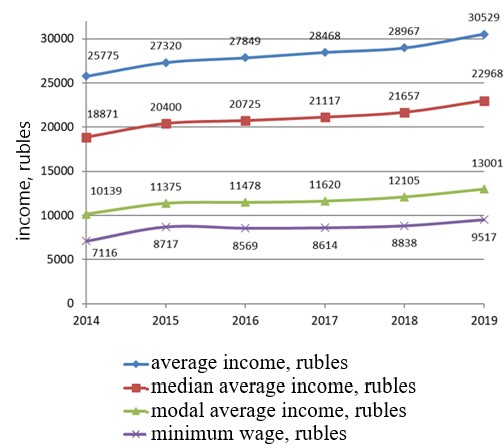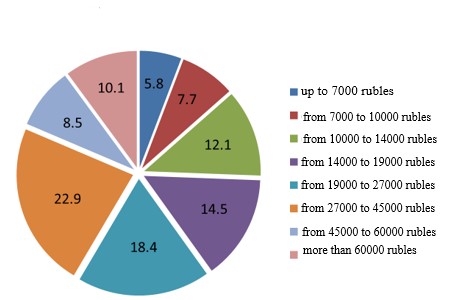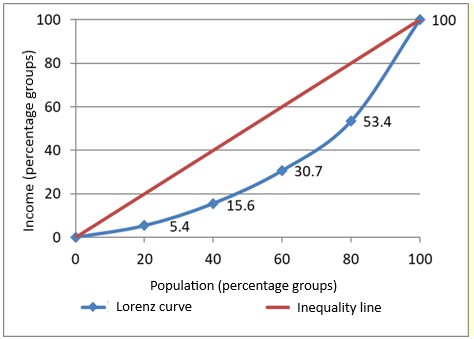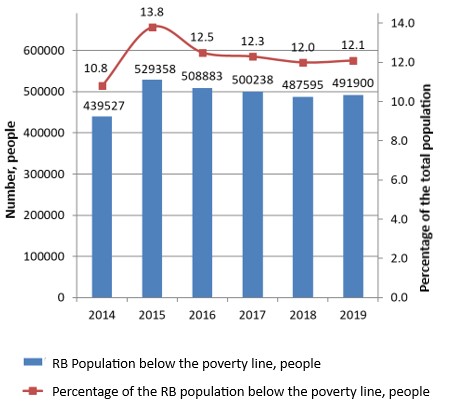Abstract
The lag of Russia behind the most developed countries in terms of the quality and standard of living of the population, as well as their high interregional inequality within the country, is one of the acute socio-economic problems. Current study is devoted to the issues of socio-economic inequality in the distribution of the population income in the pre-crisis period (2014-2019) by the example of the Republic of Bashkortostan. The following system of social indicators was chosen as the analysis basis: average, modal and median incomes, indicators of monetary income distribution by 20% of population groups, fund ratio, and the Gini coefficient. The analysis of the level and dynamics of income differentiation indicators and the level of poverty allowed assessing current changes and reveal factors and trends in the given research field. The situation in the republic is characterized by a significant differentiation of population incomes. Most of the republic population has an average per capita income slightly above the subsistence level. The fund ratio values and the Gini index demonstrate an increase in the society polarization in terms of income. The article reveals extreme manifestations of the differentiation of population living standards and income inequality, namely, the poverty of a part of the population. The share of the poor in the Republic of Bashkortostan total population during the study period was 12-13%. Proposals to reduce inequality in order to ensure sustainable economic growth and social well-being of all society segments are included in the paper.
Keywords: population income, income differentiation, socio-economic inequality, fund ratio, Gini index, poverty,
Introduction
The problems of inequality and poverty are becoming topical not only in Russia, which has faced social and demographic crises in the last decade, but have also acquired significant value in world development. The head of the IMF K. Georgieva, speaking at the Peterson Institute of World Economy, noted that inequality between various groups of the population had extremely grown against the background of a decrease in inequality between countries that has been observed in the past 20 years. For instance, in the UK, 10% of the country’s residents control wealth that is comparable to the total wealth of the population poorest half (Office for National Statistics, UK, 2018). The problem is that excessive inequality impedes economic growth and can lead to destructive social conflicts. Besides, in modern conditions, the problem of inequality in the population income distribution is complicated by the climate crisis and the strengthening of protectionism. Russian reforms and GDP growth have only led to a welfare increase of the minority in recent years. According to the researchers of Paris School of Economics, at the moment 1% of the richest citizens of Russia gain 20% of the entire country income, half of which (10% of the country’s income) falls on the oligarchs and billionaires from the Forbes list (0.1% of the population) (Novokmet, Piketty, Zucman, 2018).
Russia is the leader among other countries in the irregular distribution of wealth. The growing problem of regional inequality is no less urgent for Russia. The standard of living and income in Moscow and St. Petersburg is much higher than in small towns and distant regions of the country. If we compare the average salary level of teachers, then it is 3 times lower in the regions than in the capital. For example, in 2019, the average salary of a general education teacher in Moscow was 97.6 thousand rubles, and in Bashkortostan - 32.5 thousand rubles. (Results of federal statistical observation in the field of remuneration of certain categories of workers in the social sphere and science for January-December 2019, Federal State Statistics Service, RF, 2020). Regional inequality in income levels leads to inequality in access to qualified education, health care, and exacerbation of social tension in society. The lack of social lifts for young people embarks on accelerating the population migration from the regions to the capital. Ultimately, these processes negatively affect the socio-economic development of the region, particularly, against the background of demographic issues aggravation in the country.
Problem Statement
The Republic of Bashkortostan (RB) is one of the largest and most developed regions of Russia. Assessing the level and quality of life of the republic population by such an essential indicator as the HDI (human development index), the republic ranked 6th (0.772) among the constituent entities of the Federation in 2001 exceeding the national average (0.761). However, since 2007 the situation has changed, and its rating begins to fall (in 2010 – 18th place (0.832), in 2014 – 32nd place (0.855)). The Human Development Report of the Russian Federation for 2018 noted that the Republic of Bashkortostan began to occupy 43rd place with an HDI indicator of 0.854 in 2016. Factors of the HDI dynamics deterioration in the republic include: a decrease in the birth rate, mortality growth, an aggravation of the population health, migration loss, a lag in the literacy level of RB from the population of the Russian Federation, a retard of GRP per capita (83.8% to the Russian average per capita GRP) (Shaydullina, 2020). In this regard, the regional aspect of the income and poverty level distribution of the republic population being necessary to determine the degree and dynamics of society economic differentiation, is updated.
Research Questions
The population division into separate groups is understood as the socio-economic differentiation of the population in a broader sense, depending on the level of their income, material security, the satisfaction degree by material and spiritual needs, access to material and intangible benefits, which define the inequality of people's opportunities and the starting capabilities of their children. On the one hand, researchers argue that a low degree of differentiation stimulates the economic activity of people, motivates them to better results, and contributes to an increase in labor productivity. On the other hand, an enhanced degree of differentiation gives rise to serious consequences for the economic, demographic, socio-psychological state of society and poses a threat to social security and political stability (Bellettini, Ceroni, 2000; Balestra et al., 2018.
A number of indicators characterizing the differentiation level of population incomes and the poverty level are used in official statistics:
- average income (general level of the population average income);
- modal income (income level which is most common among the population);
- median income (income level that is in the middle of the ranked distribution series, one half of the population has a lower income, and the other half - above the median);
- decile coefficient (shows how many times the minimum income of 10% of the richest population exceeds the maximum income of 10% of the lower population);
- fund ratio (characterizes the ratio between the population average income of the tenth and first decile groups);
- income concentration index (Gini index) (characterizes inequality in the distribution of the population income between its individual groups);
- absolute poverty line (subsistence wage) (minimum standard of living is determined on the basis of physiological needs for food, clothing and housing);
- relative poverty line (the average level of household income (expenditure) is used as a base).
Purpose of the Study
The purpose of the article is to analyze the indicators of the income differentiation and the population poverty level in the Republic of Bashkortostan; designate their level and dynamics; propose ways to optimize the inequality degree and overcome poverty in order to ensure sustainable economic growth in the region and social well-being of all society strata.
Research Methods
Methods of economic and statistical analysis, a combination of quantitative and qualitative approaches, official statistics of the Federal State Statistics Service, publications in periodical literature were used in the research.
Findings
The research outcomes prove the existence of acute socio-economic imbalances in the social sphere, which are primarily expressed in the excessive economic inequality of incomes and the republic population poverty. The dynamics of statistical indicators for assessing the differentiation of the population incomes (average per capita income, median income, modal income) and their relationship with the subsistence wage in the Republic of Bashkortostan are shown in Figure 1 (Average, median and modal level of monetary income of the population in general in Russia and in the constituent entities of the Russian Federation, Federal State Statistics Service, RF, 2020).

Figure 1 shows that the average per capita income of the RB population is growing over the period under study. However, this indicator significantly exceeds the values of the median and modal incomes, which indicates a considerable differentiation of the republic population incomes. For instance, the most common income among the population was almost 2.4 times lower (13000.7 rub / month) in 2019 with an average per capita income of 30529.1 rubles per month. This means that most of the republic population has an average per capita income slightly above the subsistence wage. Comparing the data with the average Russian indicators in 2019 (per capita income - 35249.3 rub/month, Me - 26365.3 rub/month, Mo - 14750.1 rub/month, subsistence wage - 10890 rub/month) (Average, median and modal level of monetary income of the population in general in Russia and in the constituent entities of the Russian Federation, Federal State Statistics Service, RF, 2020), but the income differentiation level among Russians is also high.
A more reliable picture can be obtained by studying the population distribution in terms of average per capita income as a percentage of the total population. Figure 2 presents data for the Republic of Bashkortostan (Population distribution by per capita income, Territorial agency of Federal State Statistics Service, RB, 2020).

Figure 2 allows us to define that less than half (41.5%) of the population has an income above 27,000 rubles per month - the average value for the republic, the bulk of the population has low incomes.
Other informative indicators of social inequality are indicators of the monetary income distribution by 20% of population groups, the fund ratio, and the Gini coefficient. Table 1 presents data for the republic for the period of 2014-2019 (Distribution of total cash income and characteristics of the differentiation of monetary incomes of the population as a whole in Russia and in the constituent entities of the Russian Federation, Federal State Statistics Service, RF, 2020).
The data in Table 1 demonstrate significant income inequality, expressed in the polarization of the republic population incomes. In 2019, 20% of the republic population (1st group with lower incomes) received incomes 8.6 times less than 20% of the population with the highest incomes (5th group). At the same time, the ratio in incomes of 20% of population groups has not practically changed in recent years, despite the state policy in the field of social support and social security. The same situation is typical for Russia as a whole. The fund ratio in Russia was 15.4 in 2019. It should be noted that the maximum acceptable gap in incomes is 7 times (by the fund ratio) in developed countries, and more than 10 times is already considered a socially dangerous phenomenon.
The Lorentz curve provides a visual representation of the actual distribution of total income for each population group. A percentage scale (from 0 to 100%) is applied to plot the Lorentz curve along both coordinate axes. Percentage groups of the population are displayed on the abscissa, conventionally dividing into 5 groups of 20% of the total number, and the same percentage groups of the population income on the ordinate. The uniform distribution of income is represented by the bisector, and the uneven - by the Lorentz curve, the deviation of which from the bisector characterizes the unevenness degree (Table 2; Figure 3).
Table 2 demonstrates insignificant discrepancies; therefore, the Lorentz curves for RB and RF practically coincide.

The Gini coefficient is calculated to characterize the distribution of total monetary income between the population groups (the index of the population income concentration). The larger this coefficient is, the higher the society polarization become in terms of income.
The Gini coefficient ranges from 0 to 1. The World Bank considers inequality to be high if the coefficient exceeds 0.4. Table 1 shows that this indicator decreased to a value of 0.407 in the Republic of Bashkortostan in 2019, but remains quite high.
Another social problem - the problem of poverty is exacerbated in the context of income differentiation and living standards. In the scientific sense, poverty is a state of a person when he or she is unable to meet basic needs for food, accommodation, clothing and other vital services. Most researchers point out that economic factors of the Russian population poverty include a low level of labor productivity, significant differentiation of wages by the economy sectors, the presence of unskilled labor, an insufficient level of assistance to low-income strata of the population, etc. (Mukhtasarova, 2018). The peculiarities of Russian poverty are low-income families with children, whose incomes do not allow ensuring the material situation of family members at the level of the subsistence wage. Consequently, the low level of wages is a key factor in poverty and the receipt of low incomes by citizens of the Russian Federation. Even the average salary is not able to provide Russian citizens with acceptable living conditions.
In Russia, the absolute poverty line defines the subsistence wage, which is computed on the basis of a consumer basket cost of goods determined by the structure of expenditures on food, non-food products and services, taxes and other payments for 10% of the poorest families. The value of the subsistence wage is calculated both on average in Russia and in the country regions. In 2018, the subsistence wage in the Russian Federation was 10,213 rubles per person, in RB - 8784 rubles; for the III quarter of 2019 - 11012 and 9567 rubles, respectively. The population of the Republic of Bashkortostan with monetary incomes below the subsistence wage for the period of 2014-2019 is shown in Figure 4 (Population with cash incomes below the subsistence level in the Republic of Bashkortostan, Territorial agency of Federal State Statistics Service, RB, 2020).

Figure 4 shows an essential increase in the number of the RB poor population in 2015. The growth was associated with a sharp leap in inflationary processes and crisis phenomena in the socio-economic situation in Russia. A slight indicator decrease has been observed since 2016, which is largely due to a decline in the republic population as a whole. A minor indicator growth has been noticed since 2019. On average, the share of the poor in the republic total population is 12-13%, which is similar to the indicators for the Russian Federation. In 2021, the indicator of the median per capita income (in the Russian Federation - 11653 rubles) will be used to calculate the subsistence wage value, which may lead to a population growth living below the poverty line.
The conducted analysis of socio-economic inequality and poverty issues in the regional aspect, as well as the analysis of publications on the problem under study, showed that, on the one hand, the population stratification in terms of income proceeds in accordance with an increase in the income share of the most highly profitable fifth group, and on the other hand, due to a significant reduction in the income share of the poorest groups. From 1991 to 2018 the total income share of the 20% poorest citizens decreased in all federal districts and on average across Russia from 11.9% to 5.3%, and the income share of the 20% richest ones increased from 30.7% to 46.9%. In 2019, incomes of the 20% richest population exceeded the incomes of 20% of the poorest population by 8.6 times (Russia in numbers, 2019). Social inequality plays a disincentive role in the economy of both the country and regions and causes negative social and economic consequences. Inequality is becoming a considerable brake on economic growth, which is confirmed by researchers: an increase in the income share of the top 20% of the population by 0.007 percentage points reduces the average growth rate of economy by 0.5%. According to World Bank research, labor productivity growth is the main source of sustainable income growth and poverty reduction. Data for 29 developed and 74 developing countries from 1981 to 2018 showed that, on average, for the same period one worker of 60% developing countries produces less than 1/5 of goods that a worker in developed economies does. This gap accounts for two thirds of the world's income inequality (Kholyavko, 2020). The Russian economy demonstrates a decrease in the growth rate of labor productivity. In 2003-2008, labor productivity grew by 6% according to Rosstat data (Russia in numbers, 2019), and in 2018 - only by 1.9%. Investment in human capital plays a crucial role in overcoming inequality. According to A. Kudrin, the Chairman of the Accounts Chamber, sectors related to the human capital development are insufficiently funded: in 2011-2017, education expenses decreased from 3.7% to 3.5%, health care costs - from 3.5% to 3.3% of GDP. The growth deceleration of the number of employable citizens, aggravation of demographic problems, raw material orientation of the economy, growth of costs for the military-industrial complex, the monopolization of every economy sphere, labor migration, automation of production which causes an increase in unemployment among unskilled workers, are deteriorating the situation. The above mentioned factors are simultaneously the directions of ensuring the Russian economy growth, and the ways to overcome income inequality and fight poverty. Priority measures for overcoming inequality include:
- support from the state for families with children, payment growth for each child;
- increase in investments for the growth of the employees educational level, in scholarships for state university students;
- gain in unemployment benefits, creation of a flexible job search system;
- minimum wage increase, valorization (market value growth) of employees income of mass professions;
- pension increment, exemption from income taxes for the population poorest segments;
- tax system restructuring by shifting the main burden from income taxes to consumption taxes.
The listed measures to overcome inequality presuppose their implementation on a national scale. At the regional level, the problem solutions of reducing inequality and poverty is carried out on the basis of the region financial capabilities and the powers that the constituent entities of the Russian Federation are endowed with. The Republic of Bashkortostan has such advantages as rich and diverse natural resource potential, developed industry and transport infrastructure, recreational resources, institutional potential, business reputation, scientific, educational and innovation potential. Foremost, it is necessary to make the republic attractive for investments through participation in national projects for solving identified problems of socio-economic differentiation of the population; create favorable conditions for the development of small and medium-sized businesses in order to make additional jobs and increase the level of wages; take measures for increasing labor productivity of enterprise employees; implement projects aimed at improving the demographic situation, social support for low-income segments of the population.
Conclusion
Thus, the analysis of indicators of socio-economic differentiation of RB population has revealed that the situation in the republic is characterized by a significant differentiation of the population income. Most of the republic population has an average per capita income slightly above the subsistence wage, the fund ratio values and the Gini coefficient demonstrate an increase in the society polarization in terms of income level. Global economic troubles stemming from the 2020 pandemic are exacerbating the trend towards further increase in social inequality. Consequently, the solution to the problems of income inequality and poverty reduction lies not in the plane of increasing social payments to the population, but of creating such conditions when the injection of money into economy would create new jobs and new taxes that would compensate expenses for social needs.
Acknowledgments [if any]
References
Average, median and modal level of monetary income of the population in general in Russia and in the constituent entities of the Russian Federation, Federal State Statistics Service, RF. (2020). https://rosstat.gov.ru/free_doc/new_site/population/bednost/tabl/tab-bed1-2-6.htm
Balestra, C., Llena-Nozal, A., Murtin, F., Tosetto, E., & Arnaud, B. (2018). Inequalities in emerging economies: informing the policy dialogue on inclusive growth. OECD Statistics Working Papers, 13. OECD Publishing.
Bellettini, G., & Ceroni, C. B. (2000). Social security expenditure and economic growth: An empirical assessment. Research in Economics, 54(3).
Distribution of total cash income and characteristics of the differentiation of monetary incomes of the population as a whole in Russia and in the constituent entities of the Russian Federation, Federal State Statistics Service, RF. (2020). https://rosstat.gov.ru/free_doc/new_site/population/bednost/tabl/tab-bed1-2-4.htm
Kholyavko, A. (2020, January, 10). World Bank names the best way to fight poverty. www.news.mail.ru/economics/40137206
Mukhtasarova, E. A. (2018). State of modern Russian youth tolerance. European Proceedings of Social and Behavioural Sciences, 50, 206-213.
Novokmet, F., Piketty, Th., & Zucman, G. (2018). From Soviets to Oligarchs: Inequality and Property in Russia 1905-2016. The Journal of Economic Inequality, 1(2), 189–223.
Office for National Statistics, UK. (2018). https://www.ons.gov.uk/peoplepopulationandcommunity/personalandhouseholdfinances/incomeandwealth/bulletins/totalwealthingreatbritain/april2016tomarch2018/
Population distribution by per capita income, Territorial agency of Federal State Statistics Service, RB. (2020). https://bashstat.gks.ru/storage/mediabank/dN4074Iw/Raspredelenie-naseleniya-po-srednedushevomu-denezhnomu-dohodu.pdf
Population with cash incomes below the subsistence level in the Republic of Bashkortostan, Territorial agency of Federal State Statistics Service, RB. (2020). https://bashstat.gks.ru/storage/mediabank/Численность%20населения%20с%20доходами%20ниже%20ПМ%20.pdf
Results of federal statistical observation in the field of remuneration of certain categories of workers in the social sphere and science for January-December 2019, Federal State Statistics Service, RF. (2020). https://rosstat.gov.ru/storage/mediabank/itog-monitor05-19.htm
Russia in numbers. (2019). https://www.gks.ru/storage/mediabank/rus19.pdf
Shaydullina, R. M. (2020). Human Development Index as an Integral Indicator of the Level of Social Development of the Republic of Bashkortostan. Advances in Economics, Business and Management Research, 113, 561-564.
Copyright information

This work is licensed under a Creative Commons Attribution-NonCommercial-NoDerivatives 4.0 International License.
About this article
Publication Date
31 March 2022
Article Doi
eBook ISBN
978-1-80296-124-9
Publisher
European Publisher
Volume
125
Print ISBN (optional)
-
Edition Number
1st Edition
Pages
1-1329
Subjects
Freedom, philosophy, civilization, media, communication, information age, globalization
Cite this article as:
Shaydullina, R. M. (2022). Poverty And Social Inequality In The Republic Of Bashkortostan In 2014-2019. In I. Savchenko (Ed.), Freedom and Responsibility in Pivotal Times, vol 125. European Proceedings of Social and Behavioural Sciences (pp. 1044-1053). European Publisher. https://doi.org/10.15405/epsbs.2022.03.124

